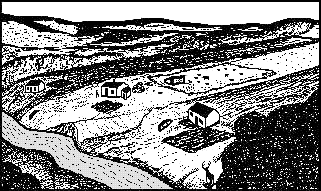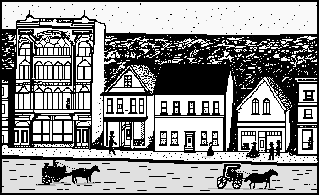








The Metis Lifestyle Compared to
That of the White
People:
The battles between the Metis and the White soldiers were going to be between two very different types of people.
The Metis enjoyed the outdoors and were used to bad weather and other hardships of living outside in the wilderness. Most of them lived on small farms where they raised livestock, grew grain, and looked after gardens.

Some of what they used was homemade, but other items such as guns and bullets were bought in stores.

Unlike the Metis, the soldiers had very little experience dealing with the problems and struggles of wilderness living. Many of them had spent their lives living in towns and cities where they had been working in offices and factories. They bought their food and supplies in stores and lived in fairly comfortable homes.
When we compare the Metis men with the White soldiers, we can see a number of important differences. The Metis had done lots of hunting, and this helped them become excellent sharpshooters. Also, many of the older Metis had gained experience and skills while fighting against the Indians.
As for the White soldiers, they were vulnerable because of a lack of fighting experience, and because they were only volunteers with very little training. The volunteers from the cities had received only twelve days of training each year. The rural volunteers had received their training at summer camps which were only held every second year. Some of them had not received any shooting practice.
Neither side was equipped the way today's modern army can be equipped. Obviously, a modern army can be far more destructive; however, the weapons used by the Metis and White soldiers still resulted in a lot of human suffering.
Most of the Metis used shot guns which had a short range, and a few owned old buffalo rifles. A few others, including Dumont, had bought long range repeating rifles. They were joined by some Indians who used guns and some who still used the bow and arrow.
For traveling, the Metis made use of the Red River cart, the wagon, and the canoe.
In comparison, the machines of the White people were impressive. They could travel by train, carriage, wagon, stagecoach, or steamship. To help them fight wars, the White people had created long range rifles, repeating rifles, field guns that used a large and powerful shell, and the Gatling gun which could fire ten bullets per second. In addition, they knew how to convert a steamer into a gunboat.

The leader of the Canadian army, Major-General Middleton, was a fifty-nine-year-old British commander who had graduated from a military college and spent most of his life in the British army.
The Troops' Journey to the North-West:
Large crowds gathered and cheered the volunteer soldiers as they left their home towns in Nova Scotia, Quebec, Ontario, and Western Canada, and headed for the trouble spots in the North-West.
Many soldiers thought they were about to go on an exciting adventure. They were going to fight a war for their country, for the British Empire, and for progress. They did not know how much suffering they would experience. The soldiers from Eastern Canada were about to face the hardships of an exhausting journey, and they would soon understand that war is destructive and brutally painful.
Their journey to the North-West was difficult because the railway had not yet been completed. In Northern Ontario, there were four large gaps in the track which the troops had to cross.
They crossed one gap by riding on sleighs. Two of the gaps required long, tough marches in the cold. In another gap, the soldiers made their way across twenty-four kilometers of barren ice. They struggled for six hours in the freezing cold and bright sun.
For days, the soldiers were hungry, sleepless, wet, and cold. Sometimes it was raining, sometimes it snowed, and sometimes the temperature got as low as -30 degrees Celsius.
On one stretch of track, they rode on flat cars that only had low sides to shield the soldiers from the wind, but the top was open. During one ten hour ride, many of the troops experienced severe frostbite, and some became so cold that at the end of the ride they could not move. They had to be lifted off the train.
At one stop, the soldiers were provided with a huge tent to sleep in. Since it was freezing, many chose to sleep in the open where they could build fires to keep warm. One soldier wrote:
Most lay with their feet toward the fire. I slept very little. Some slept soundly only to be awakened when their feet inside of their boots became so hot the soles of their boots started to smoke. They would jump up more asleep than awake, tear open their laces and get the boots off.
Another soldier wrote about riding up and down the hills and through the bush in sleighs at four o'clock in the morning. He recorded that: "The men were so tired out that they fell asleep and would then fall off of their seats into about six or seven feet [about two meters] of snow."
During this time, Dumont was making plans with Riel. Dumont later related:
I proposed we go ahead of the troops, harass them by night to make them lose heart. But Riel did not agree. I would have done so without scruple, and I would even willingly have blown up the railway…. I yielded to Riel’s judgment. I had confidence in his prayers, and that God would listen to him.
Altogether, it took about four weeks for the troops to travel half way across the country and marching from the railway tracks to the Batoche area. The better trained troops were the ones who were put into action.
The Metis chose to face Middleton's troops at a place where the trail crossed Fish Creek. They hid themselves and their horses in the bushes of the Fish Creek coulee.
When the soldiers attacked, the soldiers fought from the open at the top of the coulee where they were easy targets. Many of them were killed. In the fighting, the Metis were forced to gradually withdraw to the bottom of the coulee. From there they were hidden and protected by thick willow bushes.
At about ten o'clock that morning, a light rain began to fall, and the chilly, April rain continued for the rest of the day.
The Metis and Indians were not trained like soldiers, so when they thought it was a good idea to leave, they left. There were only forty-seven Metis left in the coulee to face over four hundred soldiers. These Metis feared an attack, so they remained hidden in the bushes and spent a lot of their time praying.
During the battle, Riel was at Batoche where he prayed with his arms stretched out to form the shape of a cross. When his arms grew tired, two Metis helped to hold them up.
The Metis people were very religious and believed that it was important that Riel pray. Most Metis would agree with the one who is recorded as saying, "I believe that prayer did more than bullets." Later, Dumont said, "I attribute our success to Riel's prayers."
Meanwhile, part of Middleton's army, which was on the opposite bank of the South Saskatchewan River, crossed the river on a barge. Now Middleton had fresh troops, but he saw that too many of his men had been killed and wounded. He refused to allow another attack.
Late in the afternoon, as the rain turned to sleet, Middleton's cold, wet soldiers were glad to withdraw. Altogether, ten soldiers died and fourty-five were wounded; on Dumont's side, five died and one was wounded. Also, fifty-five Metis and Indian horses had been killed.
At dusk a cold wind started to blow. Soon it became bitterly cold, and the sleet turned to snow. The worn out troops lay in the cold listening to the groans of the wounded and dying.
The soldiers who had crossed the river suffered the most because they had come without their overcoats and blankets. One officer wrote, "None of us are ever likely to forget the dark night of the 24th. We thought we had come out for a picnic. War's hardships are doubly cruel to the civilian soldier."
On the next day, Middleton felt shaken and exhausted. His poorly trained soldiers had performed poorly. On that day, the camp was quiet, there was very little movement, and very little was done. Throughout the camp there was a sense of gloom. Middleton felt sorry for the young soldiers who had finally experienced the realities of war.
At this time, Riel was still hoping he could negotiate a peace settlement. He wrote in his personal diary: "Oh how hard it is to wage war! O my God! Guide me, help me in war, that I may have the good fortune to conclude a peace, an honorable peace before God and Men."
However, Riel waited, and he never did get a chance to negotiate.
Middleton camped for two weeks before he felt that his army was ready to march towards another battle.
During this time, the Metis' provisional government held regular meetings. Their government decided that Riel's position was that of a prophet. Each morning, Riel brought new religious ideas to be discussed and voted on. They agreed to change the Lord’s Day from Sunday to Saturday, and they changed the names of the days of the week to religious names. Also, many of them accepted Riel’s belief that God would use a miracle to help the Metis win the next battle.
Meanwhile, Dumont made plans to defend the village of Batoche. A series of rifle pits were dug around the village. Dumont sent messengers to ask all the Indians in the North-West to join the Metis. But, most of the Indians chose to stay home. They fought their own battles. Dumont had only two-hundred and seventy-five men to face eight-hundred and fifty soldiers.

to next section.